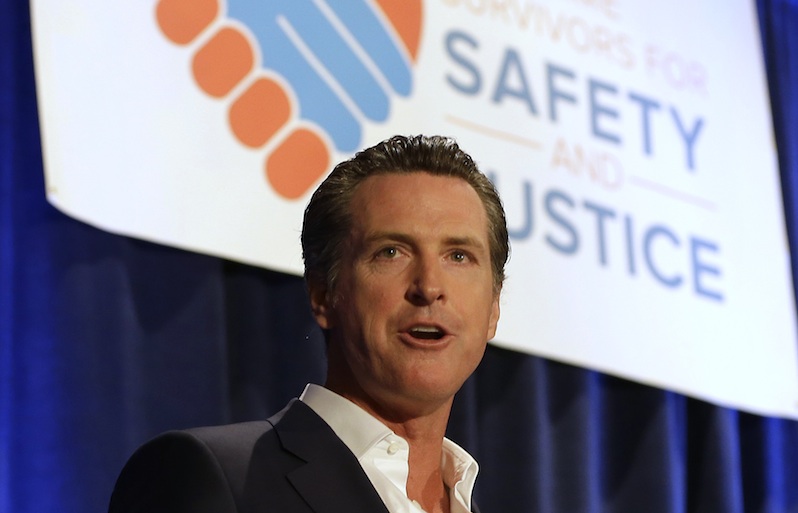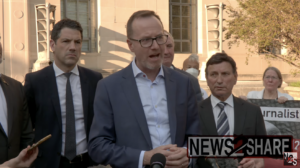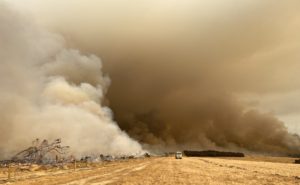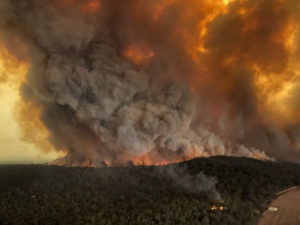Those Radical Aussies, and How They Tackled Gun Violence
What worked so well for Australia—firearm confiscation—unfortunately seems out of reach for the US Even so, there are common-sense approaches in some foreign countries that could work here Pictured right, California Lt Gov Gavin Newsom, who is proposing a 2016 ballot initiative to strengthen the state's gun laws Pictured above, California Lt. Lt. Gov. Gavin Newsom speaking in Sacramento, Calif., in April at a conference of Californians for Safety and Justice. Newsom and a gun control advocacy group are now proposing a 2016 ballot initiative to strengthen the state's gun laws by restricting ammunition sales, barring possession of large-capacity assault-style magazines and requiring gun owners to report lost or stolen guns to law enforcement. (Rich Pedroncelli / AP)
Lt. Gov. Gavin Newsom speaking in Sacramento, Calif., in April at a conference of Californians for Safety and Justice. Newsom and a gun control advocacy group are now proposing a 2016 ballot initiative to strengthen the state's gun laws by restricting ammunition sales, barring possession of large-capacity assault-style magazines and requiring gun owners to report lost or stolen guns to law enforcement. (Rich Pedroncelli / AP)
Lt. Gov. Gavin Newsom speaking in Sacramento, Calif., in April at a conference of Californians for Safety and Justice. Newsom and a gun control advocacy group are now proposing a 2016 ballot initiative to strengthen the state’s gun laws by restricting ammunition sales, barring possession of large-capacity assault-style magazines and requiring gun owners to report lost or stolen guns to law enforcement. (Rich Pedroncelli / AP)
In reflecting on the tragic shootings in San Bernardino, Calif., earlier this month in which 14 people were killed and 21 injured, let’s not be distracted from the gun debate by cries of “terrorism.”
Of course it’s necessary to look at what led a young Muslim couple to abandon their 6-month-old baby and join Islamic State’s call to slaughter. But what the shooters, Syed Rizwan Farook and Tashfeen Malik, appeared to have in common with other people driven to carry out such mass murders—in many cases white, male, American citizens—appears to be anger, alienation and easy access to semi-automatic assault weapons.
Whether or not Farook and Malik were terrorists, the assault rifles they used were purchased legally and then modified to make them more lethal. In addition, they legally acquired 6,000 rounds of ammunition. Had those weapons and ammunition been harder to come by, perhaps they might have thought longer and harder about other ways to vent their rage.
Although hotly debated, certain “common sense” gun laws have been statistically proved to significantly reduce bloodshed.
● Permit-to-purchase laws, which are contingent on the purchaser passing a background check. ● Prohibiting people with domestic violence restraining orders from owning a gun. ● Expanding federal denial criteria to include those who have been convicted of violent misdemeanors. ● Making gun manufacturers adopt more stringent safety features, among them “smart” guns that can be discharged only by an authorized user.
According to Evan DeFilippis and Devin Hughes, the founders of Armed With Reason, “… [T]he combined influence of these policies could prevent only ten percent of our nation’s more than 33,000 annual gun deaths. That would still be the equivalent of preventing the 9/11 terrorist attacks, every single year.”
California Lt. Gov. Gavin Newsom hopes to add one more item to this list: a ballot measure, slated for 2016, that would require background checks on ammunition purchases, ban large-capacity magazines and institute mandatory reporting of lost or stolen guns. This would make California the first state to require background checks at the point of sale for ammunition.
Then there’s a more radical approach, one that requires the political courage to put popularity and gun lobby donations aside in the name of doing what it takes. Australia is the oft-touted example of how a mandatory gun buy-back program changed a nation’s course.
But there are other issues that need addressing as well. Outreach to Muslim communities in the United States and abroad would do worlds to heal rifts, just as increased funding of mental health services and anti-bullying programs in schools might have prevented homegrown acts of terrorism by boys who felt separate, unequal and lost. But uncontrolled anger plus guns equals a recipe for only one kind of ending.
Here’s a startling fact, from an article in The Atlantic: “America’s gun control laws are the loosest in the developed world and its rate of gun-related homicide is the highest. Of the world’s 23 ‘rich’ countries, the US gun-related murder rate is almost 20 times that of the other 22. With almost one privately owned firearm per person, America’s ownership rate is the highest in the world; tribal-conflict-torn Yemen is ranked second.”
Gun violence isn’t like Ebola or any other communicable disease for which we haven’t found a cure. When it comes to gun violence, the “doctors” are hemming and hawing, worrying that “we might make some of our patients (and board members) unhappy if we give them medicine that tastes bad.”
On the heels of the San Bernardino shooting, our Democratic leaders once again offered feeble promises, while for Republicans the incident appeared to offer more fodder to prove that Muslims are the enemy, and that we should all go out and arm ourselves to the teeth.
Republican presidential candidate Ted Cruz held a pro-gun rally at an Iowa range, Smith & Wesson stocks rose, and the Senate voted down two gun control measures, one to expand background checks and one to forbid individuals on the Terror Watchlist to purchase firearms. Republican front-runner Donald Trump declared he would ban Muslims from entering the country, while some other Republicans defended the rights of individuals on the Terror Watchlist to bear arms. Are they for real?
Meanwhile, apparently bloodshed by bullets is good for the gun industry, because gun sales are booming. In some states, sheriffs are encouraging residents to arm themselves.
Here’s a small sampling of the facts:
● Every day in the U.S., there’s more than one gun massacre; most don’t make the national news. According to shootingtracker.com and gunviolencearchive.org, shootings of four or more victims occur almost daily, on average.
● Every day in our country, 88 people die from gun violence: 31 are murdered; 53 kill themselves; two die unintentionally; one is killed by police intervention; and one dies from unknown intent.
● Every day, 208 people are shot and survive: 151 are shot in an assault; 10 survive a suicide attempt; 45 are shot unintentionally; two are shot in a police intervention.
● Since the Newtown, Conn., school slaughter three years ago, there have been more than 160 school shootings.
I was beginning to wonder if this is our new normal recently when I ran into some military pilots on leave from service in Dubai, Afghanistan, Iraq and places they did not have permission to disclose. This led to a conversation on war, raising boys and gun control. Had you asked what I thought a group of military men would say about gun control, I’d have been 100 percent wrong—because these men turned out to be Australian.
Over the course of the discussion, the men gave me a glimpse into how Australians view American paralysis in the face of gun violence. Two of them agreed to let me quote them anonymously, on account of military restrictions about speaking to the press.
One of the pilots grew up in the small island state of Tasmania, the site of Australia’s worst mass shooting, in 1996. His father was one of the schoolteachers who taught the boy who would grow up to become the shooter. After the massacre, he said, “Our government went, ‘You know what? We’re going to do something about it.’ ”
He watched as members of his church parish reluctantly handed in their weapons during the famous mandatory gun buyback of 1996, pushed through by John Howard, then Australia’s prime minister. He was “pretty much our Ronald Reagan,” the pilot told me, “and there was massive backlash.”
“We look back 20 years later and you won’t find many Australians that will go that wasn’t a great idea,” he said. “We haven’t had a single mass shooting in 20 years. [Even] suicides went down. I’ve married an American who will refuse to raise her kids in [the U.S.].”
According to a study by Andrew Leigh of Australian National University and Christine Neill of Wilfrid Laurier University, total intentional gun deaths fell by half in the decade after the 1996 restrictions were put in place, even as Australia’s population grew nearly 14 percent. Gun suicides dropped 65 percent from 1995 to 2006, and gun homicides fell 59 percent.
Even conservative U.S. columnist Charles Krauthammer recently hailed this kind of confiscation program as the only viable solution to gun violence, but also said it was doomed because of the Second Amendment and the power of the National Rifle Association. “As for the only remotely plausible solution, Obama dare not speak its name. … There’s a reason he didn’t bring up confiscation. … In this country, with its traditions, public sentiment and, most importantly, Second Amendment, them’s fightin’ words.”
On the other side, DeFilippis and Hughes—whose blog is “dedicated to academically refuting pro-gun myths, and providing a scholarly defense of gun control”—say, “We don’t need gun confiscation to save lives. We can do it through common-sense gun reform.”
Whichever solution you opt for, extreme gun violence in a land that is supposed to be the home of the free necessitates extreme measures. Whose freedom are we protecting these days? Freedom for those who seek to arm themselves or freedom for our children to go to school, freedom for the rest of us to go to work, to attend our place of worship, to go to college and come back home alive?
Another of the Australian pilots joined in our conversation, while one of his friends showed me photos of how to refuel a fighter jet at 36,000 feet above a warring country at 50 below zero Celsius.
“When you have the ability to go and purchase an automatic weapon with copious amounts of ammunition, and then you have the ability to walk into a primary school and shoot 6-year-olds in the face … that’s the worst. I cannot understand,” he said. “We go into shops here and there’s guns everywhere. Then a massacre happens and everyone’s saying, ‘It’s not the gun’s fault. … If that [kid] had a gun, he’d have been able to shoot the gunman and there wouldn’t have been any problem.’ To me that’s just crazy.”
Your support matters…Independent journalism is under threat and overshadowed by heavily funded mainstream media.
You can help level the playing field. Become a member.
Your tax-deductible contribution keeps us digging beneath the headlines to give you thought-provoking, investigative reporting and analysis that unearths what's really happening- without compromise.
Give today to support our courageous, independent journalists.






You need to be a supporter to comment.
There are currently no responses to this article.
Be the first to respond.